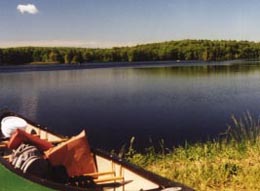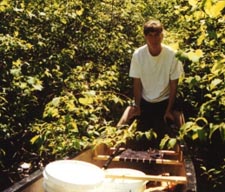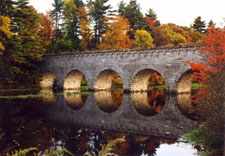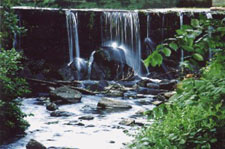Organization for the Assabet River
Damonmill Square
Concord, MA 01742
Tel: 978-369-3956
Email: oar@assabetriver.org
|
Two days, one night on the Assabet |
|
||||||||||
| |
|||||||||||
|
A canoe trip from the headwaters
by Sophie Wadsworth
May 27, 2000 Through purple loosestrife and grasses we push the canoe into the water and slowly climb in. The stream is barely wider than the canoe. We shove off with our paddles, taking our first strokes, our blades scraping the bottom. We have begun a two-day trip down the Assabet River from its headwaters in Westborough to the river's end, over 31 miles later, at Egg Rock where it joins the Sudbury River to form the Concord. I am paddling with my friend, Tom Faber, in his Old Town canoe. Although we've both canoed sections of the Assabet, neither of us has seen the entire river, and we are curious about what it might be like to paddle from Westborough to Concord in a single trip.
We put in at the Mill Road boat ramp on the Assabet Reservoir in Westborough. Fishermen were pulling their boats out as we slid ours in at 8:00 a.m. We paddled to the Nichols dam and portaged the canoe over the hummock of earth that separates the reservoir from the river. Our boat contains a small library of field guides in a 10-gallon pail, including our favorite, Ron McAdow's The Concord, Sudbury and Assabet Rivers: A Guide to Canoeing, Wildlife, and History. Also packed are camera gear, a tent, sleeping bags, two days' food, and life-preservers. It takes most of our strength to portage it over the hill. Where does the Assabet begin: at Assabet reservoir? The brooks which feed the reservoir? Or this stream bed? Does the river begin in the clouds, or from deep springs? How can something as wayward as a river have a precise "beginning" anyway? As we paddle we hear a red-winged blackbird trilling "ok-a-lee ok-a-lee." Then the banks close in. We plunge into thick brush, and the canoe stops.
The shrubs grow so thick we must bushwack more than paddle through dense thickets of gray dogwood, multi-flora rose, red maple, and river grape. At points you wouldn't know the river was even there; it feels like we're following a rivulet through a deep thicket. All this affirms what the guide books say: we are well above the Assabet's "navigable waters." In fact, if we hadn't gotten so much rain this spring, we would be carrying the canoe down this first stretch. As it is, we alternate between poling the canoe forward with our paddles and getting out to pull it over the streambed. We hold one arm up to shield our eyes from branches. Twigs crack, leaves snap off. We joke: 'There's enough kindling in the bottom of the canoe to start a fire. And enough varieties of spiders and ants to do an invertebrate study just inside this canoe!" Suddenly, we are coughing uncontrollably. Maybe it's the pollen in the air, possibly the wild grape. A crash through a thicket of leaves- a deer- we see its white tail, startled by us and we're by it. Finally, the brush opens up. Hot and scratchy, we climb into the river to swim. It's noon. We check McAdow's guide book: we've gone one mile. Tom jokes, "We'll be camping in Westborough center." Paddling again, we smell chlorine and hear a stream flow in. It's the effluent from the Westborough Wastewater Treatment Plant, a stream that appears equal in flow to the Assabet itself at this point. Immediately downstream, the canopy opens and we see painted turtles sunning themselves. A two foot long snapping turtle rests on the bank, too. There is significantly more flow now, also more aquatic vegetation: underwater we see thick green plants, perhaps waterweed, and a long grassy one that resembles water celery. A meadow vole darts into thick grasses on the bank. Up close we can see raccoon, otter, and deer tracks in the mud. We also notice arrowwood, alders, and pickerelweed. The honeysuckle has just passed flowering and the nannyberry and the yellow pond lily are in bloom. Stinging nettle, currants, and green briars grow here too. Northborough Just ahead, a pair of Canada geese hiss at us, necks outstretched; a flock of goslings hurry in front of one goose's prodding beak while the other keeps hissing. We follow the river's snaking course through Northborough's Juniper Hill Golf Course. Passing under a small bridge, we startle a flock of barn swallows whose nests are clustered on the underside of the bridge. It feels like we're canoeing right through a golf green- and we are. Through the clear shallow water you can see white golf balls lying on the river bottom. A spotted sandpiper dabs at the shore. Buttonbush lives along the sunny banks.
As we glide under a beautiful railroad bridge, an arch of rough hewn stone blocks, we hear only the dripping of water off our paddles. Winterberry, highbush blueberry, and skunk cabbage grow here. We are many miles upstream from the military land of the U.S. Army's Sudbury Annex, but here inexplicably, a gigantic army tank looms over the river bank. We reach a large fallen tree which we pull the canoe over, and then, two strokes later, must lie flat on our backs to slide under a red maple, just barely. Our heads are lower than the gunwales and yet the leaves still graze our faces. At the Sawmill Dam portage, across Route 20, we see an orange sign: "Custom Parts for Your Harley Davidson." When the traffic breaks, we cross carrying canoe and gear, walk through a field, and eat lunch at the put-in. Back on the Assabet, we paddle the whitewater below the dam. We watch a kingbird catching insects. More upland trees grow here: oaks, maples, and beech.
Another portage at Woodside Dam: we haul the canoe up the steep bank, over a guardrail, across a road. Soon we're paddling through a floodplain where the river flows slowly but makes such snaking turns that if we fail to hug the inside of each bend, we head straight into the opposite bank. Dry clumps of grass and leaves hang from low branches, signs of the river's height during May's heavy rains. The sweet fragrance of the flowering willows fills the air. We greet a man who is wading upstream, pulling a boy in a kayak. "The river ends up ahead," the boy tells us, straight-faced. The father nods in agreement. Could we have taken a wrong turn somewhere? We check our guide book which reassures us that it's only another portage that lies up ahead. Soon, a massive concrete structure with metal storm grates rises in the distance: the Tyler flood-control dam. Here the river does seem to end as the Assabet flows unseen underneath it. I can barely slip my flattened hand in the gap of air between the concrete and the water, it's that narrow. McAdow says if we were muskrats we could swim the pipe under it. But we'd never get the canoe through. It's a tough haul, dragging the canoe full of gear up and over the steep dike. We count: one ... two ... three ... then pull, count, then pull. Back on the river, a great blue heron rises from the marsh and slowly flaps its broad wings, disappearing into the trees. A wide bridge spans the river under Route 290. Every sound echoes as we paddle down the length of its cool tunnel, leading us to sing notes at random, our voices echoing as if in a huge cathedral. We name it the Singing Bridge. Hudson When we hear an ice cream truck's jingling music we know we are approaching Hudson. Kids play on swings in Riverside Park, and chimney swifts call overhead. We take out above the Washington Street Dam, at the Hudson fire station parking lot. Yellow iris blooms at the water's edge. To portage through Hudson town center we haul the canoe and gear through Veteran's Park, down a sidewalk and, in a break in the traffic, cross Route 85. It takes two trips. 8:00 p.m: we still have five miles to the halfway point, and we haven't eaten dinner yet. We hide the canoe behind a building and buy eggplant subs, which we eat afloat. Is it because we're so hungry that they taste divine? Just below Hudson, where you can still see houses standing close together, two beavers plunge into the river, not far from a large willow branch with a chewed end. Broad cattail marshes come into view as coolness settles over the river. Stow The clouds have turned dusky pink by the time we find a place to camp. We hear red-winged blackbirds trilling and the cry of a red-tailed hawk. Then a veery's call and a Baltimore oriole. Pines lean and wave their brushing branches. We dip our hands in the river like two raccoons and agree that this is one of our favorite sections of the Assabet. Green frogs across the river sound like plucked banjo strings. I wonder if the very water that has traveled with us from the headwaters passes our campsite while we sleep. Perhaps by morning it will flow as far as our destination in Concord. May 28, 2000 We wake to a beaver swimming downstream around the bend. Ahead, two herons fly slowly towards the broad slope of Stow's Orchard Hill. Ron McAdow writes that it's a drumlin, a hill rolled into a lump by glacial action, and its grasses provide good nesting habitat for bobolinks. At Gleasondale Dam we drag the canoe out on the left bank, at the edge of someone's backyard. A man waters the lawn. We have difficulty locating where to take out, but the portage is a short and easy carry crossing a backyard at the river's edge. A little stretch of whitewater carries us past Gleasondale's red brick mill buildings to a lovely meandering section of the Assabet. The river is banked with grasses, arrow arum, as well as blueberry, winterberry, alders and oaks. We approach the Sudbury Annex, military land that the U.S. Fish and Wildlife Service expects to acquire shortly for conversion into the Assabet River National Wildlife Refuge. A model airplane, loud as a real biplane, rumbles overhead. Seems like a lot of noise for one person to have fun. We pass a burned area of pinewoods where most of the trees have brown needles and the trunks are partly burned, their bark singed a strange copper color. We find a television bobbing in the water. Also, nearby, a long aluminum landscaping rake. We haul them both into the canoe, propping up the rake behind the t.v. in the stern. The fishermen who troll by us may think we've got a t.v. with one giant antenna on board. As we cross the calm backwater above Ben Smith dam, dozens of fins break the surface of the water. They are carp, mating. Pairs chase each other, tails wriggling, and some swerve close enough to rock the canoe. Maynard Below the Ben Smith dam, paddling at a fast pace in a strong current, the end of the landscaping rake snags on an overhanging branch. The canoe jolts to a halt, nearly capsizing us, and lurching me halfway out of the stern. After we regain our balance and detangle the rake, we have a good laugh at our foolishness. It's cloudy now, and cool. We approach the Maynard Wastewater Treatment Plant and the nearby site of the Acton plant, currently under construction. Dumpsters are located at the river's edge behind some stores; one overflows with Styrofoam peanuts that spill down the bank. A bright hill of snow stands behind the Valley Sports skating rink, as if winter lingers in one last place. A lesser yellowlegs wades near shore, dabbing the water with its beak. We find a bicycle helmet in the water, grimy, but it fits perfectly and gets added to the gear in the canoe. West Concord At Powdermill Dam in West Concord, we meet two men fishing at the take-out. "Caught a largemouth bass," one reports. We hear the lovely calls of the scarlet tanager and woodthrush. The current below the dam takes us quickly downstream to Damonmill where we wave to OAR's office. We float past a backyard picnic and two German shepherds who follow us, barking, along the shore. The canopy along this section is especially dense and shades much of the river. Silver maples and oaks, arching high above the river, touch their leafy branches. At Route 62 we take out before the stone bridge. A dumpster above the landing spreads loose trash towards the river. We follow raccoon tracks up the bank and walk into West Concord Center for ice cream, in no hurry to reach our destination. Concord The last stretch of the Assabet. The tree's reflections ripple where we dip our paddles. On this section of river, past Route 2, other paddlers appear, a kayaker, and then two people and two dogs in a canoe. We pass the stone tablet dated 1896 in memory of George Bradford Bartlett, a devotee of the Assabet, "By the ancient hemlocks grim and gray our boat drifts slowly on its way. . . ." Where the sunlight comes through the hemlocks the water is shot through with a milky light, and blue and brown colored stripes of shade. The river widens at Egg Rock, the Sudbury's waters flow in, joining with the Assabet. For a little ways we dip our paddles into the Concord River. During two days on this river, paddling over 31 miles through nine towns, we have been astonished at the variety of river's flow and the terrain along its banks, from rapids to mill ponds, and from marshes to pinewoods. We enjoyed a lot of quiet, too, seeing more muskrats than people on the Assabet, during this sunny Memorial Day weekend. And we were amazed by the diversity of wildlife: how many kinds of shrubs and flowers, the range of bird songs, and animals. Nathaniel Hawthorne had it right when he wrote of the Assabet in Mosses from an Old Manse: "A more lovely stream than this. . . has never flowed on earth,- nowhere, indeed, except to lave the interior of a poet's imagination." Late afternoon at the landing by the Old Calf Pasture in Concord, we pull the canoe out one last time. Beyond the sound of wind in the maple leaves, song sparrows and a red-winged blackbird sing as if, like the river itself, they will never end.
Special thanks to Tom Faber whose humor and wise understanding of the natural world made this trip a pleasure and significantly contributed to this article.
|
|||||||||||





